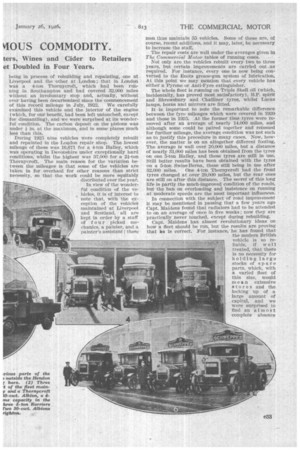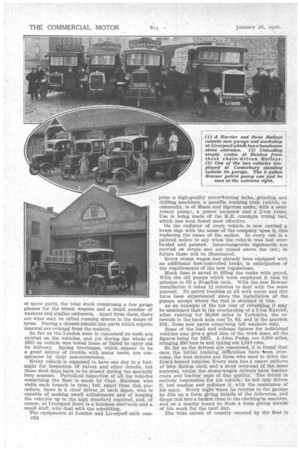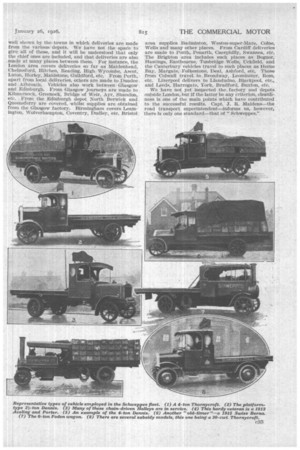THE TRANSPORT 01 vIOUS COMMODITY.
Page 16

Page 17

Page 18

Page 19

If you've noticed an error in this article please click here to report it so we can fix it.
How Schweppes; Ltd., Distribute thei Throughout the Country. T1
ters, • Wines and Cider to Retailers et Doubled in Four Years.
THE extraordinary development of road transport within the past few years is often difficult to realize. It is only when one enters upon the task of ,analyzing a specific example that the fact is brought home with real force. In the passenger-carrying business the results present themselves in a clearer light, but in goods haulage they are not so apparent.
As an instance of the growth in the latter direction we may refer to the remarkable expansion of the fleet owned by Schweppes, Ltd., the well-known manufacturers of high-class table waters, particularly as with this growth is coupled a vast increase in the area of the ground covered and the opening up of factories and garages in all parts of the country.
In a former article dealing with the Schweppes transport system, which we wrote in April, 1921, we expressed our surprise at the size of the fleet which then existed, this comprising eight steam wagons and 24 petrol vehicles, a total of 32. At that time there were factories in London, Liverpool, Leeds, Plymouth, Bristol and Bridge of Earn. The mileage for the year 1920 was approximately 124,000, and 20,000 tons of goods were• carried. Compare these figures with those of today. The total fleet now amounts to 72 vehicles, which are distributed amongst 15 different centres. The mileage in 1925 amounted to over 500,000, and the total tchinage to 81,000, this comprising 45,000 outwards and 36,000 tons inwards.
Not many fleets are so representative as that of Schweppes, Ltd. It may, therefore, be of interest to deal with the vehicles in detail. So far as steam wagons are concerned, there are two 5-ton Aveling and Porters, which have been running since July, 1913, three 6tonners of Foden make and a 6-ton Sentinel. The oldest members of the petrol fleet are three SwissBerna 4-tonners, which have been running since August, 1915. They were bought at a time when British vehicles were unobtainable. There are eight 5-tonners, two 4-tonners and twelve 3-tonners of Halley make and chain driven, whilst the remaining Halley is a 2-ton -live-axle model. Of the Karriers there are seven, of which one is a 2-tonner, whilst the others are built to carry 5 tons. Of the Thornycrofts the 4-tonners num ber eleven, the 2-itonners three, and one is of the 30 cwt. subsidy type. Albions are also represented by 30 cwt. subsidy models, of which there are •three.
Finally, there are 14 Dennis ma chines of 4-ton capacity and a 21tonner of the same make. At one or two of the centres where the vehicles are retained they are garaged out, but in the majority of the factories and depots new garages have been provided. At Liverpool there is not only a new garage, but a repair shop and a five-gallon Bowser pump. Eight vehicles are maintained here. There is a new garage at Colwall, where there are two vehicles; and one at Glasgow, which also has a pump and maintains eight vehicles, including those operating from Bridge of Earn and Edinburgh. New garages and pumps have also been provided at Cardiff, Canterbury, Brighton and Southampton, which have two, two; four and three vehicles respectively. Five vehicles are kept at Leeds, two at Birmingham, one at Edinburgh, two at Bridge of Earn, two at Plymouth, two at Bristol and two at Manchester attached to Liverpool, whilst 32 are kept at the headquarters in London, where the main repair shop and two five-gallon Bowser pumps are provided.
The policy adopted is to station the vehicles as close as possible to their sources of production. For instance, all those working in Scotland are of Scottish make, whilst the greater proportion of those at Leeds and Coiwall are Karriers. The -London vehicles are mostly of Dennis, Thornycroft, Aveling and Porter and Foden makes.
It is of interest to mention that at the time of our chat with Capt. J. R. Maidens, A.M.I.Mech.E., out of the whole fleet only two were off their wheels, these' being in process of rebuilding and repainting, one at Liverpool and the •other at London ; that in London was a 4-ton Thornycroft, which had been running in Southampton and had covered 82,000 miles without an involuntary stop and, actually, without ever having been decarbonized since the commencement of this record mileage in July, 1922. We carefully examined this vehicle and the interior of the engine (which, for our benefit, had been left untouched; except for dismantling), and we were surprised at its wonderful condition. The carbon deposit on the pistons was under in. at the maximum, and in some places much less than this.
During 1925 nine vehicles were completely rebuilt and repainted in the London repair shop. The lowest mileage of these was 10,671 for. a 4-ton Halley, which was operating in Devonshire under exceptionally hard conditions, whilst the highest was 37,000 for a 24-ton Thornycroft. The main reason for the variation be tween the mileages is that some of the vehicles are taken in for overhaul for other reasons than strict necessity, so that the work could be more equitably distributed over the year.
In view of the wonderful condition of the vehicles, it is of interest to note that, with the exception of the vehicles maintained at Liverpool and Scotland, all are kept in order by a staff of four picked mechanics, a painter, and a painter's assistant ; these
men thus maintain 55 vehicles. Some of these are, of course, recent additions, and it may, later, be necessary to increase the staff.
The repair costs are well under the averages given in The Commercial Motor tables of running costa.
Not only are the vehicles rebuilt every two to three years, but certain improvements are carried out . as required. For instance, every one is now being converted to the Enots grease-gun system of lubrication. At this point we may mention that every vehicle has either a Pyrene or Anti-Fyre extinguisher.
The whole fleet is running on Triple Shell oil (which, incidentally, has proved most satisfactory), B.P. spirit and Shrewsbury and Challiner tyres, whilst Lucas lamps, horns and mirrors are fitted.
It is important to note the remarkable difference between the tyre mileages which were covered in 1920 and those in 1925. 'At the former time tyres were removed after an average of nearly 14,000 miles, and although some could be paired together and reissued for further mileage, the average condition was not such as to justify this procedure in many cases. Now, however, the matter is on an altogether different footing. The average is well over 20,000 iniles, but a distance of nearly 31,000 miles has been obtained from the tyres on one 5-ton Halley, and these tyres are still in use. Still better results have been obtained with the tyres on a 5-ton Swiss-Berna, these still being in use after 32,000 miles. One 4-ton Thornycroft had the front tyres changed at over 29,000 miles, but the rear ones are still on after this distance. The secret of this long life is partly the much-improved condition of the roads, but the ban on overloading and insistence on running at moderate speeds are the most important influences.
In connection with the subject of road improvement it may be mentioned in passing that a few years ago Capt. Maidens found that radiators had to be attended to on an average of once in five weeks; now they are practically never touched, except during rebuilding.
Capt. Maidens has almost revolutionary ideas on how a fleet should be run, but the results are proving that laa is correct. For instance, he has found that the modern British vehicle is so reliable, if well treated, that there is no necessity for holding large stocks of spare parts, which, with a varied fleet of this size, would wean extensive stores and the locking up of a large amount of capital, and we were surprised to find an almost complete absence of spare parts, the total stock comprising a few gauge glasses for the steam wagons and a small number of washers and similar oddments. Apart from these, there are what may be called running spares in the shape of tyres. During a chassis rebuild any parts which require renewal are ordered from the makers.
So far as the London area is concerned no tools are carried on the vehicles, and yet 'during the whole of 1925 no vehicle was towed home or failed to carry out its delivery. Spring breakages, which appear to be a great source of trouble with many users, are conspicuous by •their non-occurrence. _
Every vehicle is supposed to have one day in a fortnight for inspection of valves and other fletalls, but these shed days have to be missed during the specially busy seasons. Periodical inspection of all the vehicles comprising the fleet is made by Capt. Maidens, who visits each branch in turn; but, apart from this procedure, there is a chief driver,at each depot, who is capable of making small adjustments and of keeping the vehicles up to the high standard required, and, of course, at Liverpool there is a foreman mecl,anic and a small staff, who deal with the rebuilding. The equipments at London and Liverpool each cornc34
prise a high-quality screwtutting lathe, grinding and drilling machines, a paraffin washing tank (which, incidentally, is of Mann and Egerton make, with a semirotary pump), a power hacksaw and a 2-ton crane. Use is being made of the K.B. crankpin truing tool, which has been found most effective.
On the radiator of every vehicle is now carried a brass sign with the name of the company upon it, this replacing the name of the maker. In every cab is a painted notice to say when the, vehicle was last overhauled and painted. Interchangeable signboards are carried on struts. and are raised above the cab; in future these will be illuminated.
Every steam wagon has already been equipped with an additional foot-controlled brake, in anticipation of the requirements of the new regulations.
Much time is saved in filling the tanks with petrol. With the old pumps which were employed it took 9i minutes to fill a 20-gallon tank. With the new Bowser installation it takes i minutes to deal with the same amount. No petrol troubles at all with water and dirt have been experienced since the installation of the pumps, except where the fuel is obtained in tins. As an example of the low cost of rebuilding it may be mentioned that in the overhauling of a 5-ton Karrier, after running for 26,000 miles in Yorkshire, the renewals in the back axle cost tls. 8d. and in the gearbox 10d., these new parts comprising felt washers only.
Some of the load and mileage figures for individual vehicles may give a good idea of the work done, all the figures being for 1925. A 6-ton roden ran 8,000 miles, bringing 990 tons in and taking out 1,610 tons.
So far as the drivers are concerned, it is found that once the initial training difficulties have seen overcome, the best drivers are those who used to drive the firm's horsed vehicles. Every man has a smart uniform of blue Melton cloth and a stout overcoat of the same material, whilst the steam-wagon drivers have leather coats and leather caps of fine quality. The driver is entirely responsible for his vehicle; he not only drives it, but washes and polishes it, with the assistance of his mate. Every night when he returns to the garage he fills up a form giving details of the deliveries, and drops this into a basket close to the clocking-in machine, and on a nearby board he finds a form giving details. of his work for the next day.
. The wide extent of country covered by the fleet is
well shown by the towns in which deliveries are made from the various depots. We have not the spae to give all of these, and it will be understood that only the chief ones are included, and that deliveries are also made at many places between them. For instance, the London area covers deliveries sofar as Maidenhead, Chelmsford, Hitchen, Reading, High. Wycombe, Ascot, Luton, Honey, Maidstone; Guildford, etc. . From Perth, apart from local , deliveries, others are made to Dundee and Arbroath. Vehicles also work between Glasgow . and Edinburgh. From Glasgow journeys are made to Kilmarnock, Greenock, Bridge of Weir,. Ayr, Shandon, etc. From.. the Edinburgh depot, North Berwick and Queensferry are covered, whilst supplies are obtained from the Glasgow factory. Birmingham covers Leam-ington, Wolverhampton, Coventry, Dudley, etc. Bristol
area supplies 13adminton, Weston-super-Mare, Colne, Wells and many other places. From Cardiff deliveries are made to Perth, Penarth, Caerphilly, Swansea, etc. The Brighton area includes such places as Bognor, Hastings, Eastbourne, Tunbridge Wells, Uckfield, and the Canterbury vehicles travel to such places as Herne Bay, Margate, Folkestone, Deal, Ashford, etc. Those from Colwall travel to Broadway, Leominster, Ross, etc. Liverpool delivers to Llandudno, Blackpool, etc., and Leeds, Harrogate, York, Bradford, Buxton, etc.
We have not yet inspected the factory and depots outside London, but if the latter be any criterion, cleanliness is one of the main points which have contributed to the successful results. Capt. J. R. Maidens—the road transport superintendent—informs us, however, there is only one standard—that of " Schweppes."




























